Trees, Shrubs and Woody Vines
Media
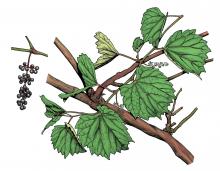
Species Types
Scientific Name
Vitis rupestris
Description
Sand grape is a bushy, sprawling, or trailing woody vine found along rocky streambeds or gravel bars. It rarely climbs but may reach a length of 8 feet. It lacks tendrils.
Media
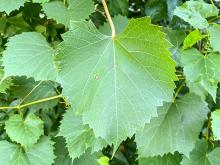
Species Types
Scientific Name
Vitis species
Description
Eight species of grapes in the genus Vitis are native or naturalized in Missouri. All bear edible fruits. Like their relatives elsewhere, they have important connections to humans and to nature.
Media

Species Types
Scientific Name
Rosa multiflora
Description
Starting more than a century ago, this nonnative rose was planted across America — for many good reasons — but multiflora rose has proven to be invasive, and now the goal is to stop its spread.
Media

Species Types
Scientific Name
Rosa setigera
Description
Also called climbing rose, prairie rose is most common near woodlands, where it climbs and trails on neighboring shrubs and small trees.
Media

Species Types
Scientific Name
Rubus flagellaris
Description
Dewberry is a lot like common blackberry, except that instead of being a small shrub, its canes form trailing woody vines. Both plants are prickly, and both produce delicious deep purple berries!
Media

Species Types
Scientific Name
Rubus allegheniensis
Description
Common blackberry is only one of several species of blackberry in our state. It grows in rocky, open woods, along bluffs and fencerows, on glades, and in thickets, old fields, and open valleys nearly statewide.
Media
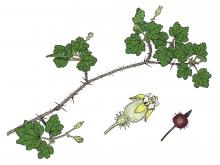
Species Types
Scientific Name
Ribes cynosbati
Description
Prickly gooseberry occurs mostly in the eastern half of Missouri. Its spine-covered berries turn reddish purple when ripe. Despite the prickles, they are edible.
Media
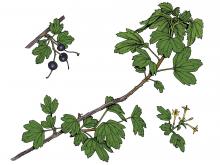
Species Types
Scientific Name
Ribes odoratum (syn. R. aureum)
Description
Golden currant is an erect to arching, spineless shrub up to 6 feet high that bears edible fruit. It is uncommon in the western part of the Ozarks. The flowers have a strong fragrance reminiscent of spicy cloves or sweet carnations.
Media
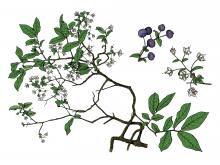
Species Types
Scientific Name
Vaccinium stamineum
Description
Deerberry is an irregularly branched shrub, rarely more than 6 feet high. A blueberry relative, it bears edible blue fruits.
Media
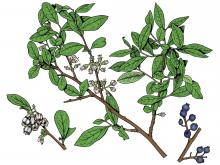
Species Types
Scientific Name
Vaccinium pallidum (syn. V. vacillans)
Description
Lowbush blueberry is a stiffly branching shrub to 3 feet high. The berries are tasty raw or cooked in pies, muffins, and preserves. It is mostly found south of the Missouri River. It often grows in extensive colonies.
See Also
About Trees, Shrubs and Woody Vines in Missouri
There are no sharp dividing lines between trees, shrubs, and woody vines, or even between woody and nonwoody plants. “Wood” is a type of tissue made of cellulose and lignin that many plants develop as they mature — whether they are “woody” or not. Trees are woody plants over 13 feet tall with a single trunk. Shrubs are less than 13 feet tall, with multiple stems. Vines require support or else sprawl over the ground.





















